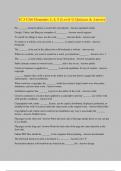Nonmarket Strategic Management Voinea & Kranenburg
Nonmarket Strategic Management (Voinea & Kranenburg)
Index
Chapter 1 – Genesis of the Nonmarket Field 2
Chapter 2 – Advancing the Nonmarket Environment: Expanding Institutions, Issues, Interests and
Information 4
Chapter 3 – Institutions: Nature, Context and Pressures 7
Chapter 4 – Types of Nonmarket Institutions 9
Chapter 5 – Stakeholder Approach to the Nonmarket Concept 11
Chapter 6 – Nonmarket Strategies: Why, When and How? 15
Chapter 7 – Nonmarket Resources and Outcomes 18
1
,Nonmarket Strategic Management Voinea & Kranenburg
Chapter 1 – Genesis of the Nonmarket Field
Neoclassical Economics
According to this perspective, nonmarket forces regulate exchanges between economic actors outside the
market system. It focused on the determination of prices, outputs, and income distributions in market by
means of supply and demand. The relationship between firms and markets was explained by either
exogenizing nonmarket factors or by neutralizing their effects altogether. Nonmarket factors are exogenous:
market games are played in isolation from nonmarket factors. Neoclassical economics largely ignored other
non-economic exchanges beyond those of hierarchical functions of institutions. This perspective
acknowledged the existence of the nonmarket effects but considered them as separated and neutral to the
market mechanisms and firms.
Criticism: it is deficient in considering the implications of political, social and legal factors on market
mechanisms or economic activity.
Organization Theory
This perspective regards nonmarket mechanisms as cooperating with market endeavours. This cooperation
assumes a socialized or bounded rationality. Organization theory presumes that there are issues regarding
exchanges that cannot be completely foreseen or regulated by market mechanisms or transaction cost
economics which are both rationally bounded. This les to the need for nonmarket exchange mechanisms,
around two elements:
1. Nonmarket exchange mechanisms became necessary for improving the efficiency of market exchange
mechanisms as these are plagued by information asymmetry, property rights, bargaining and other
problems. Nonmarket institutions have the explicit purpose of regulating transactions and solving
market failures.
2. Social behavior is also involved in market exchanges under the forms of trust, commitment, and
opportunistic behavior, which influence the behavior of firms on economic exchange and networking.
Normative rules are necessary to limit inefficiencies and injustices caused by bounded rationality and
opportunistic behavior within market exchanges.
Where market mechanisms fail, nonmarket matters serve to remedy market failure and to act as a higher
hierarchy (party control) for conflict resolution in market exchanges. This perspective gradually builds the
role or function of nonmarket matters.
Criticism: it neglects to consider social aspects’ involvement in market activities or exchanges, and it
overlooks the informal and formal aspects of economic activity or market mechanisms. Moreover, the
utilization of economic and sociological terms are far from consistent in the literature related to this
perspective, leading to treacherous analogies.
Political Theory
Political mechanisms complement the nonmarket field by discussing ‘voice’ mechanisms, referring to politics.
In this case organizations use ‘voice’ mechanisms to appeal to higher hierarchies or institutions. For political
scientists, nonmarket refers to the power-based correctives used to improve all organizations when
competition fails to repair market mechanisms. Society’s welfare would be optimized only when all
organizations (mainly of market nature) compete among themselves. If competition does not lead to the
‘exit’ of inefficient or ineffective organizations, then political ‘voice’ is needed to change objectionable states
of affairs. In this perspective, nonmarket is related to the use of power – rights to exert influence over others
who deploy the same rights to resist such attempts. Nonmarket ‘voice’ repairs market failure or inefficient
market mechanisms and political mechanisms complement the nonmarket environment as related to power.
Sociology
This perspective starts reasoning from the point of view of societies. For survival, societies need social
integration, social institutions, collective interests, and motivating values (on top of economical factors,
normative rules and voice mechanisms). Nonmarket aspects are regarded as often conflicting with
interdependent market ones. From this perspective, nonmarket institutions were regarded as generating
2
, Nonmarket Strategic Management Voinea & Kranenburg
wealth, power, solidarity and social order. Social institutions were regarded as rules and regulations insuring
social welfare and buffering the society from possible consequences of market failures. ‘Social institutions’
refer to complex social forms that reproduce themselves (e.g. governments, family, universities). Due to the
variety that can be considered within ‘social institution’, these also need to be distinguished from more
complex and more complete social entities, such as societies or cultures, of which any given institution is
typically a constitutive element. Social institutions are ‘establishments of relative permanence of a distinctly
social sort’ characterized by essential elements as: a set of mores or rules (consistency) fulfilled by peoples
acting collectively, in established complementary capacities or offices (concert).
The Nonmarket Concept
Nonmarket refers to internal and external organizing and correcting factors that provide order to market and
other types of institutions and organizations so that they may function efficiently and effectively as well as
repair their failures. The nonmarket environment encompasses those interactions between the firm and
individuals, interest groups, government entities, and the public that are intermediated by public and private
institutions. ‘Nonmarket environment’ is often left poorly defined, if defined at all. The opposite, market, is
often not clearly defined either because it has different meanings.
The nonmarket refers to:
a. Values expressing the purpose pursuit of public interests.
b. Internal and external interchange mechanisms of coercion and cooperation that complement and
balance competition in a reciprocal manner at various level of interaction.
c. Relationship among market and nonmarket organizations resting principally on their actors’
sovereignty rights.
d. The conflictual integration in the light of their failures of society’s economic, political, social, and
cultural organizations.
Main differences between the market and nonmarket environment
Market environment Nonmarket environment
An institution through which economic exchange is Various institutions including public ones governed by majority rule,
governed by unanimity rule. collective action, and publicness.
Rights are given to the participants in economic Rights are given to parties outside economic exchange, such as:
exchange. government officials, interest groups, activists, media, and the public.
Actions are voluntary and result in private benefits. Actions are not always voluntary and produce public benefits affecting
a broader group of parties.
Transactions can be better seen as physical and provide Transactions can be better seen as interactions and provide public
private benefits. benefits.
Some actions are prohibited in the market environment Some actions which are prohibited in the market environment are
(e.g. cartels). allowed in the nonmarket environment (e.g. collusion and
monopolization).
Performance is evaluated in terms of profits or value Performance is evaluated in terms of ethical principles, legitimacy, or
created. concepts of responsibility.
Financial performance. Social performance.
Core elements of the market and nonmarket
Market environment Nonmarket environment
Predictability Uncertainty
Money (Context-specific) Information
Leadership: beat competition Coalitions: need the support of others
Flexibility: to create or maintain competitive advantage Consistency: follow social and ecological guidelines, values and norms
Creating value for customers, owners, society Creating shared value: integrating environmental values with
organization’s values
Shared value creation focuses on identifying and expanding the connections between societal and economic
progress. It is integral to a company’s profitability and competitive position. It leverages the unique resources
and expertise of the company to create economic value and by creating social value.
3







